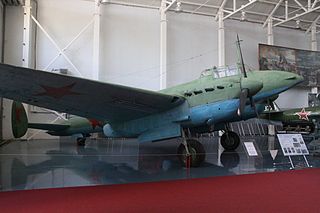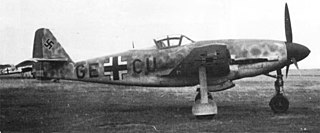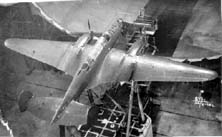
The Arado Ar 240 was a German twin-engine, multi-role heavy fighter aircraft, developed for the Luftwaffe during World War II by Arado Flugzeugwerke. Its first flight was on 10 May 1940, but problems with the design hampered development, and it remained only marginally stable throughout the prototype phase. The project was eventually cancelled, with the existing airframes used for a variety of test purposes.

The Heinkel He 177 Greif (Griffin) was a long-range heavy bomber flown by the Luftwaffe during World War II. The introduction of the He 177 to combat operations was significantly delayed by problems both with the development of its engines and frequent changes to its intended role. Nevertheless, it was the only long-range, heavy bomber to become operational with the Luftwaffe during the conflict. The He 177 had a payload/range capability similar to that of four-engined heavy bombers used by the Allies in the European theatre.
The OKB-1 '140', was a jet bomber produced in the USSR from 1947.

The Petlyakov Pe-2 was a Soviet twin-engine dive bomber used during World War II. One of the outstanding tactical attack aircraft of the war, it also proved successful as a heavy fighter, as a night fighter and as a reconnaissance aircraft. The Pe-2 was, numerically, the most important Soviet bomber of World War II, at their peak comprising 75% of the Soviet twin-engine bomber force. The Soviets manufactured Pe-2s in greater numbers during the war than any other twin-engine combat aircraft except for the German Junkers Ju 88 and the British Vickers Wellington. Several communist air forces flew the type after the war, when it became known by the NATO reporting name Buck.

The Myasishchev M-4 Molot was a four-engined strategic bomber designed by Vladimir Mikhailovich Myasishchev and manufactured by the Soviet Union in the 1950s to provide a Long Range Aviation bomber capable of attacking targets in North America.

The Yakovlev Yak-3 is a single-engine, single-seat World War II Soviet fighter. Robust and easy to maintain, it was much liked by both pilots and ground crew. One of the smallest and lightest combat fighters fielded by any combatant during the war, its high power-to-weight ratio gave it excellent performance and it proved to be a formidable dogfighter.

The Yakovlev Yak-9 is a single-engine, single-seat multipurpose fighter aircraft used by the Soviet Union and its allies during World War II and the early Cold War. It was a development of the robust and successful Yak-7B fighter, which was based in turn on the tandem-seat advanced trainer known as the Yak-7UTI. The Yak-9 started arriving in Soviet fighter regiments in late 1942 and played a major role in retaking air superiority from the Luftwaffe's new Focke-Wulf Fw 190 and Messerschmitt Bf 109G fighters during the grand Battle of Kursk in summer 1943.

The Messerschmitt Me 309 was a prototype German fighter, designed in the early years of World War II to replace the Messerschmitt Bf 109. Although it had many advanced features, the Me 309's performance left much to be desired and it had so many problems that the project was cancelled with only four prototypes built. The Me 309 was one of two failed Messerschmitt projects intended to replace the Bf 109, the other being the 1943 Me 209 project.

The Yermolayev Yer-2 was a long-range Soviet medium bomber used during World War II. It was developed from the Bartini Stal-7 prototype airliner before the war. It was used to bomb Berlin from airbases in Estonia after Operation Barbarossa began in 1941. Production was terminated in August 1941 to allow the factory to concentrate on building higher-priority Ilyushin Il-2 ground-attack aircraft, but was restarted at the end of 1943 with new, fuel-efficient, Charomskiy ACh-30B aircraft diesel engines.

The Klimov M-105 was a V12 liquid-cooled piston aircraft engine used by Soviet aircraft during World War II.

The Klimov VK-107 was a V-12 liquid-cooled piston aircraft engine used by Soviet aircraft during World War II.

The Vickers Type 432 was a British high-altitude fighter aircraft developed by the Vickers group during the Second World War. Intended to enable the Royal Air Force to engage the enemy's high-altitude bomber aircraft, it was to be armed with six cannon.

The Ilyushin Il-102 is a Soviet experimental jet-powered ground-attack aircraft designed by Ilyushin. This aircraft was never chosen for production, being surpassed by the Su-25. Only a few development prototypes were built.

The Arkhangelsky Ar-2 was a Soviet dive-bomber used in small numbers during World War II. Its design was a refinement of the earlier Soviet Tupolev SB.

The Savoia-Marchetti SM.91 was a two-seat, twin-engined, Italian heavy fighter prototype, designed to compete in a 1942 revision to a long-range fighter-bomber contract offered by the Regia Aeronautica to Italian aircraft companies in 1938. The original 1938 specification yielded the Savoia-Marchetti SM.88, which the SM.91 was largely based on.

The Polikarpov SPB (D) (Skorostnoy Pikiruyushchy Bombardirovshchik (Dalnost)—High Speed Dive Bomber (Distance)) was a Soviet twin-engined dive bomber designed before World War II. A single prototype and five pre-production aircraft were built, but two crashed and the program was cancelled in favor of the Petlyakov Pe-2.

The Mikoyan-Gurevich I-320 was a prototype Soviet long-range all-weather interceptor aircraft of the late 1940s-early 1950s. Only two were made, with no production following.

The CANSA FC.20 was a twin engine reconnaissance bomber/ground attack monoplane designed and built in Italy in 1941. Several versions with different armament and engines were flown but only the FC.20bis ground attack variant reached squadron service, in very small numbers, before the 1943 armistice.
The Bartini T-117, was a twin-engined cargo aircraft designed by Robert Ludvigovich Bartini in the USSR from 1944-1948.
The Ilyushin Il-26 was a late 1940s project for a strategic heavy bomber by the Ilyushin Design Bureau. There were a variety of alternative engines proposed for the Il-26, including the 3,400 kW (4,500 hp) Shvetsov ASh-2TK piston engine and 4,500 kW (6,000 hp) Yakovlev M-501 diesel engine. The specifications varied according to the number and type of engines proposed.

















